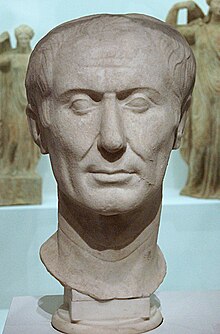Tusculum portrait

The Tusculum portrait, also called the Tusculum bust, is the only extant portrait of Julius Caesar possibly made during his lifetime.[1] It is also one of the two accepted portraits of Caesar (alongside the Chiaramonti Caesar) which were made before the beginning of the Roman Empire.[2] Being one of the copies of the bronze original,[3] the bust is dated to 50–40 BC and is housed in the permanent collection of the Museo d'Antichità in Turin, Italy.[4] Made of fine-grained marble, the bust measures 33 cm (1ft 1in) in height.
Description[]
The portrait's facial features are consistent with those on coins struck in Caesar's last year, particularly on the denarii issued by Marcus Mettius.[3] The bust's head is prolonged, forming a saddle shape which was caused by Caesar's premature ossification of the sutures between the parietal bone and the temporal bone.[2] The portrait also exhibits dolichocephalia.[2] The bust has a wrinkled neck, the result of Caesar's years campaigning in extreme weather conditions, a feature that is omitted in other posthumous busts. This feature characterizes Caesar as a general rather than a ruler, unlike later busts.[5] The portrait's hair is present but thinning. These realistic features place the bust in the tradition of verism more than other surviving Caesar portraits.[6]
In modern day[]
The Tusculum portrait was excavated by Lucien Bonaparte at the forum in Tusculum in 1825 and was later brought to , though it was not recognised as a bust of Caesar until Maurizio Borda identified it in 1940. The portrait was exhibited in the Louvre alongside the Arles bust. There are three known copies of the bust, in Woburn Abbey and in private collections in Florence and Rome.[4][7]
See also[]
- Arles bust, possible third lifelike Caesar portrait.
References[]
- ^ Tom Stevenson (2014). Julius Caesar and the Transformation of the Roman Republic. Routledge. ISBN 978-1317597537.
- ^ a b c The J. Paul Getty Museum (1987). Ancient Portraits in the J. Paul Getty Museum: Volume 1. Getty Publications. p. 27. ISBN 0892360712.
- ^ a b Miriam Griffin, ed. (2009). A Companion to Julius Caesar. John Wiley & Sons. p. 302. ISBN 978-1444308457.
- ^ a b Amelia Carolina Sparavigna (2012). "Portraits of Julius Caesar: a proposal for 3D analysis". arXiv:1206.4866 [cs.CV].
- ^ Frel, Jiří (1977). "Caesar". The J. Paul Getty Museum Journal. 5: 55–62. ISSN 0362-1979.
- ^ Toynbee, J. M. C. (1957). "Portraits of Julius Caesar". Greece & Rome. 4 (1): 2–9. ISSN 0017-3835.
- ^ Zanker, Paul (29 April 2009). "The Irritating Statues and Contradicting Portraits of Julius Caesar". In Miriam Griffin (ed.). A Companion to Julius Caesar. John Wiley & Sons. p. 302. ISBN 978-1-4443-0845-7.
External links[]
| Wikimedia Commons has media related to Tusculum portrait. |
- Marble sculptures in Italy
- 1st-century BC Roman sculptures
- Archaeological discoveries in Italy
- 1825 archaeological discoveries
- Busts of Julius Caesar
- Busts in Italy